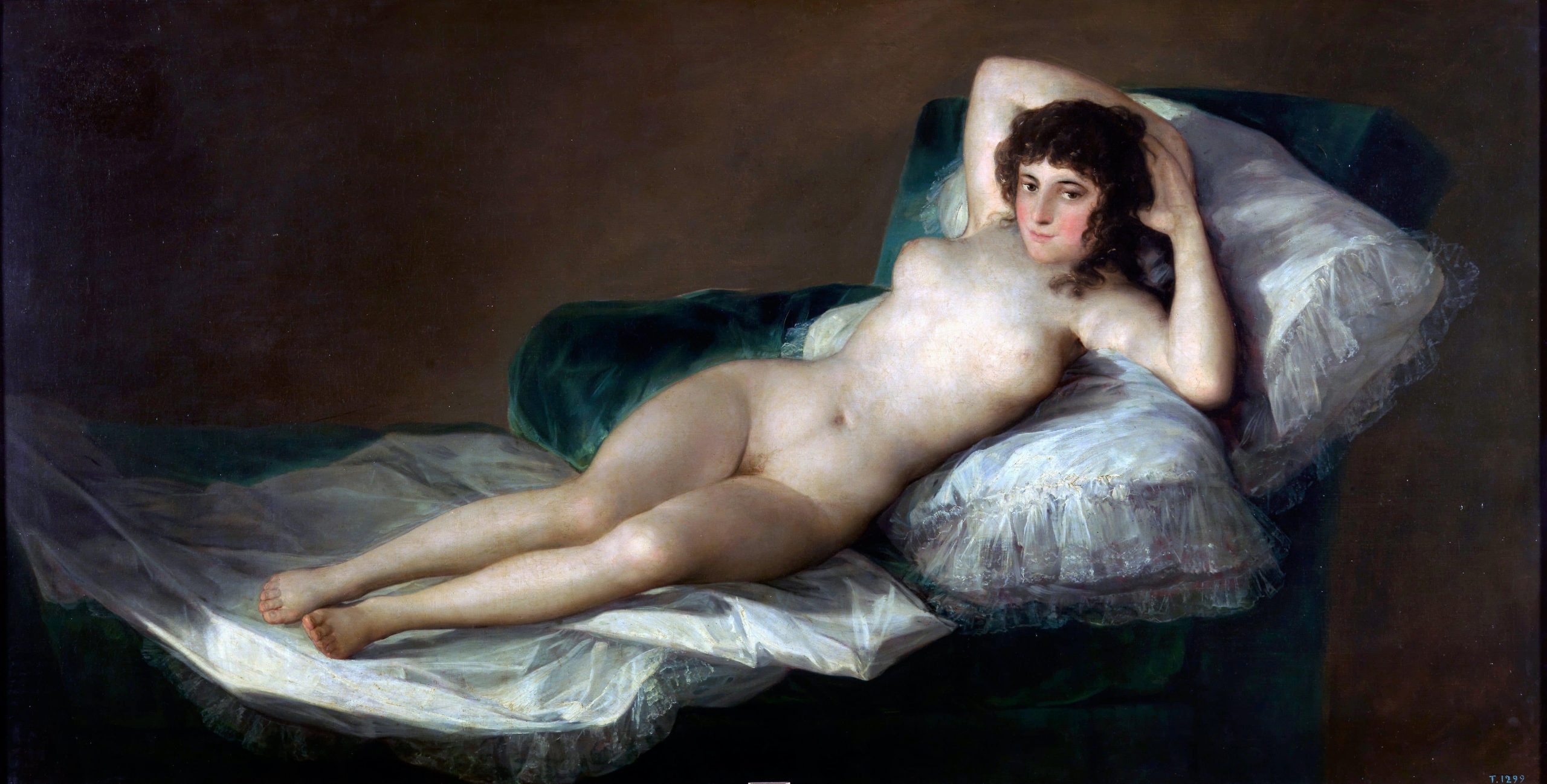
In 2003, a Gucci campaign conceived by Tom Ford and shot by Mario Testino caused a scandal. The ad featured the model Carmen Kass, pulling down her underwear to reveal her pubic hair shaved into the shape of the brand’s “G” logo. Although Gucci stated it was “intended to be the ultimate ironic pun for a sexy brand in a logo-led age”, it was strongly criticised.
Perhaps the most shocking thing about the ad was not the male model crouching by her crotch, but the brazen depiction of female pubic hair.

Female pubic hair in Western art has long been a controversial subject. Until the mid-19th century, it effectively did not exist. Where female nudes were painted with pubic hair, the intention was often to portray that woman as savage or sexually deviant.
In Heinrich Aldegrever’s 1529 engraving ‘Eve With a Stag’ (1529), Eve’s supposed ‘sinfulness’ is represented through her gaze, staring into the eyes of the serpent, the apple that she clutches in her left hand, and her stylised pubes.
The Ancient Greeks are in part to blame for this association of female pubic hair with the sort of lasciviousness that triggers disaster. The Greeks articulated their obsession with physical perfection through the notion of an idealised female form: goddesses incarnate in smooth, innocent-looking marble. The impact of classical sculpture – and in particular Praxiteles’ ‘Aphrodite of Knidos’ (4th century B.C.) – on centuries of Western art, cannot be underestimated.
The idea that pubic hair equated to an unladylike expression of sexuality persisted in visual culture through the Middle Ages and the Renaissance. In Botticelli’s ‘Birth of Venus’ (1480s), the goddess conceals herself with her golden hair. Although artists began to use prostitutes as female models and nudes began to look more realistic and less idealised – as in Giorgione’s ‘Sleeping Venus’ – pubic hair was still out of the question.

Venus of Urbino
Titian’s ‘Venus of Urbino’ (1534) both protests her modesty and titillates the viewer with a teasingly placed hand. The dark shadow around Venus’ pubic area, although it is no more than a bold allusion to body hair, plays not only with the viewer but also with artistic conventions.
These conventions were so powerful that even the Renaissance’s most famous female painter, Artemisia Gentileschi – who would have known the reality of female body hair far better than her male counterparts – never so much as hinted at it in her art. After being raped by her tutor and enduring the exposure of a high-profile rape trial, Gentileschi’s painting – especially depictions of female victimhood (‘Susanna and the Elders’) and vengeance (‘Judith Slaying Holofernes’) was brave enough as it was.
ArrayArrayFrancisco Goya, La Maja Desnuda, 1797
So when did representations of female pubic hair become commonplace in visual culture? Arguably, they still haven’t, even in 2021. But two seminal works shook the establishment. The first was Francisco Goya’s ‘La Maja Desnuda’ (1797), in which a reclining nude stares invitingly at the viewer, a ghost of fuzz between her legs and under her arms. It is frequently cited as the first ‘neutral’ depiction of female pubic hair in Western art – that is to say, devoid of any connotations of sin or prostitution.
Unsurprisingly, perhaps, Goya was hauled before the Inquisition in 1815 for the ground-breaking, unabashed ‘immorality’ of the work. The second came in 1866 with Gustave Courbet’s ‘L’Origine du Monde’. Even today, the full-frontal vulva and wiry black forest still have the power to shock. There was the occasional nude sporting a bold tuft (like Gustave Caillebotte’s ‘Woman Reclining On A Couch’), but these continued to be exceptions.
After all, painting was strictly guarded by convention, especially in France, where the Académie des Beaux-Arts set out iron-clad rules (subjects were often classical, with allegorical nudes and ideas of female beauty borrowed from clean-shaven Ancient Greece). It was these stifling constraints that the Impressionists were seeking to subvert. And yet, even some of the most revolutionary works of the nineteenth century shied away from female pubic hair.
Take Manet’s ‘Olympia’, for example: the confrontational gaze and unashamed allusions to prostitution caused an uproar, but even this daring nude hides her pubic area.

Heinrich Aldegrever, Eve with a Stag, engraving, 1540
In this context, the work of Swedish painter Anders Leonard Zorn (1860-1920) seems all the more remarkable. Although Zorn was best known for his buttoned-up portraits of respectable society figures (including King Oscar II of Sweden and three American presidents), he was also one of the first to paint female nudes – and with pubic hair – in a public outdoor setting. Given that previously, pubic hair in visual culture had been equated with pornography or a dangerous female sexuality, what is so refreshing about Zorn’s hairy nudes is their innocence.
With his respectable list of patrons, Zorn was hardly an iconoclast bent on tearing up the artistic rulebook (unlike some of the painters pushing boundaries in Montmartre and Montparnasse), but his work stands out in his own way. Unlike many paintings featuring pubic hair, where odalisque-like poses betray at a deliberate eroticism, Zorn’s scenes are characterised by a tranquil, non-sexual nudity.
ArrayHokusai, The Dream of the Fisherman’s Wife, 1814, woodcut, British Museum
In ‘Reflections’ (1889) and ‘Nude by the Shore’ (1914) a woman paddles unselfconsciously in the shallows. In ‘Two Friends’ (c. 1890) the women’s untamed bush is echoed in the lush vegetation in the foreground and background. Zorn’s models, with their fleshy stomachs and abundant pubes, are as natural as the settings in which they find themselves. Their body hair might be wild, just like their rural surroundings, but in these realistic depictions there is no judgement on behalf of the male painter.
Such naturalistic representations of female body hair have remained rare. All too often, as in Paul Gauguin’s paintings of women on the island of Tahiti, it is sexualised or fetishised. Doubly uncomfortable for contemporary viewers are the orientalist overtones in Gauguin’s work. In ‘The Delightful Land’ (1892), in which Gauguin reimagines the Garden of Eden, Eve is a Tahitian woman with dark pubes and a shifty expression.
Although a hirsute Eve has historic precedent, Gauguin often paints the Tahitian women to similar effect, and the context is not always comfortable. In ‘Nevermore’ (1897), Pau’ura (the artist’s ‘vahiné’ or companion) lies exposed in an atmosphere of palpable unease. The Courtauld Gallery, which owns the painting, suggests that “the vulnerability of this figure is suggestive of the broader context of this painting: that of Tahiti’s relationship with France, a colony under the yoke of a powerful European power”.

Paul Gauguin, The Delightful Land, 1892
As the twentieth century progressed, depictions of female pubic hair gradually became less taboo. However, the majority of works featuring female pubic hair in this period were painted by men – and it shows. Perhaps the most obvious painter of this kind was Amedeo Modigliani: his ‘Female Nude’ (1916), ‘Nude on a Blue Cushion’ (1917) and ‘Reclining Nude’ (1917) – which was sold at Christie’s in New York in 2015 for $170.4 million – are striking for their explicit pubic hair.
The sensuous nudes were deemed so controversial that the police shut down his exhibition at Berthe Weill’s gallery in 1917.

Modigliani
As the art historian Werner Schmalenbach observed, “the nudes are wholly liberated, even if the artist himself had no thought of making them a liberating gesture”, but the confident sexuality of Modigliani’s models is complicated by ‘Oriental’ influences in his work.
Modigliani’s interest in Egyptian and African art is well-known; are the hairy models in his ‘Nudes’ a nod to the nineteenth century idea of non-western women as wild, sexually deviant and correspondingly unshaven, or are they a more straightforward expression of female power and desire?

Egon Schiele
However, when compared to some of the nudes in the German-speaking world at the time, Modigliani’s work appears sensitive, almost respectful. Egon Schiele’s nudes have an electric charge, teetering between alluringly pornographic and unhinged violence. In ‘Reclining Female Nude With Legs Spread’ (1914), the provocative pose draws attention to the woman’s dense bush, with the arm thrown back to proudly reveal her armpit hair, too.
In ‘Woman With Black Stockings’ (1913), Schiele places the woman’s luxuriant pubic hair and peachy vulva at the centre of the composition. The effect is unashamedly carnal. There is no mistaking Schiele’s intentions here. But while Schiele’s nudes are raw, others are altogether more disturbing. The pubic hair in Otto Dix’s ‘Nude (For Francisco Goya)’ (1926) bursts angry and spider-like from the prostitute’s grotesque body. The art critic Donald Kuspit described the image as “the Triumph of Death over youth and beauty”; far from pubic hair as a celebration of female eroticism, here it is a weapon in the artist’s arsenal, deployed to make us feel revulsion.
ArrayPaula Modersohn-Becker, Reclining Mother and Child, 1906
What a relief, then, that women began to take the narrative into their own hands. The German expressionist Paula Modersohn-Becker (1876-1907) was the first woman to paint a nude self-portrait. Her ‘Reclining Mother and Child’ (1906) could not be further from the eroticism of Modigliani or the brutality of Schiele; Modersohn-Becker’s work is brimming with innocence and shared intimacy. The most extraordinary thing about it is the depiction of pubic hair in a maternal, rather than sexual, context. But even when painted by women artists, female body hair can be incendiary.
In 1949, the 19-year old oil heiress Pat Ladew commissioned a portrait from the American figurative artist Alice Neel. The resulting nude – with legs open to reveal a fuzzy vulva, and an insouciant, almost manly stare – was bold and realist. The problem was, it was too realist. Pat Ladew was horrified; after initially demanding that Neel cover up the neat pubes with underwear, Ladew rejected the painting altogether. When it appeared in public in 1978, the thirty intervening years hadn’t diluted the shock factor; Ladew threatened to sue and the row made headlines. “I respect Alice, but her stuff is too intimate to live with”, Ladew complained to People magazine.
It is something that still has the power to raise eyebrows. The 1970s – that era of bra-burning feminism – is perhaps the decade most associated with body hair in the popular imagination, but it didn’t shake off the lingering taboo. In 1999 Germaine Greer was still arguing in The Whole Woman that a “woman who desported herself in a bikini out of which a bush of pubic hair sprouted would be regarded as a walking obscenity”. More recently, a tangle of dark pubes are a regular feature in Tracey Emin’s autobiographical drawings, but this doesn’t mean it has become any less contentious. After all, Emin built her “enfant terrible” reputation through confronting audiences with uncomfortable truths. Her representations of what it is to be a woman can be powerful and empowering, but they are also marred by sexual violence.
So how much has changed? Painters like Goya, Courbet and Modigliani blurred the boundaries between ‘high’ and ‘low’ art and broke new ground by portraying women who were both unapologetically hairy and erotic. But even today, like with the Gucci campaign, visual representations of female pubic hair have the ability to raise more than a few eyebrows.




